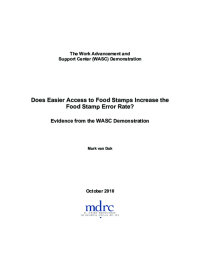Does Easier Access to Food Stamps Increase the Food Stamp Error Rate?
Evidence from the WASC Demonstration
Although many states are taking steps to offer simplified access to the food stamp program, little is known about the effect this might have on food stamp error rates. The Work Advancement Support Center (WASC) demonstration was aimed at helping individuals in low-wage jobs boost their income over the long term by increasing their hours of work or hourly wage or by acquiring employer-provided benefits and over the short term by making the most of available work supports, such as publicly funded medical insurance for adults and children, tax credits, child care subsidies, and food stamps. An interim report, released in June 2009, covering early impact results, showed that WASC increased food stamp receipt rates in two sites. As part of that demonstration and at the request of the of the U.S. Department of Agriculture Food and Nutrition Service, MDRC conducted a food stamp quality control (QC) study in two of the sites (Dayton, OH, and San Diego, CA). The results show that WASC had no impact on the food stamp quality control error rate in San Diego but increased the error rate in Dayton. The reason for the increase in Dayton is not clear, but may be due to the fact that Dayton encouraged different types of individuals to apply for and receive food stamps, such as those who were older, more likely to have children, more likely to have a GED or higher degree, or more likely to retain a job covered by unemployment insurance over four consecutive quarters — people whose income tend to fluctuate more. Once the differences in characteristics were accounted for in the analysis, the WASC demonstration had no impact on the food stamp QC error rate in Dayton.






